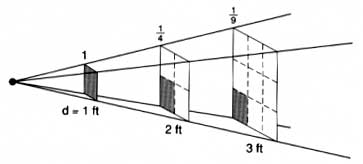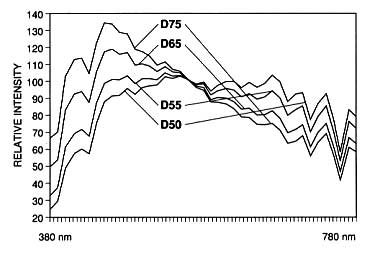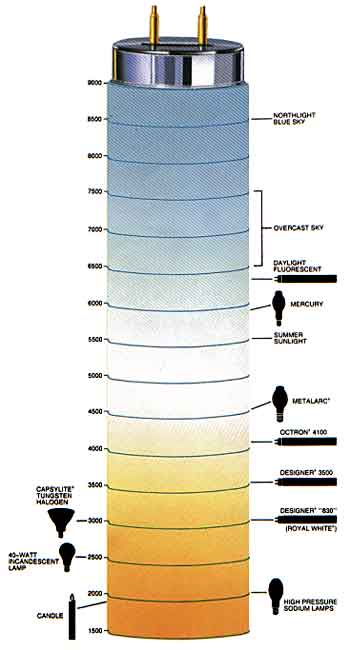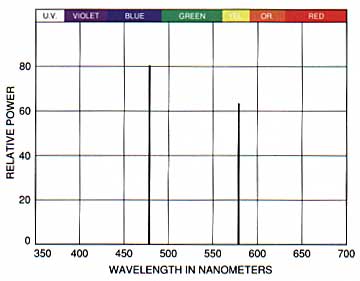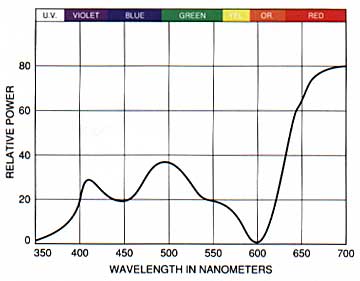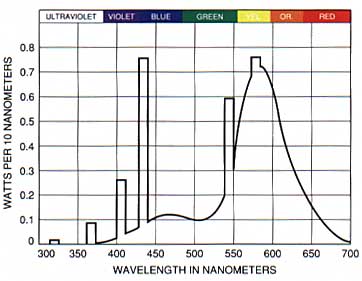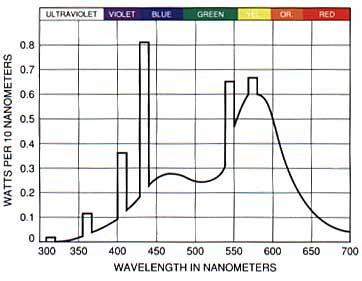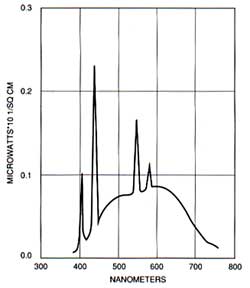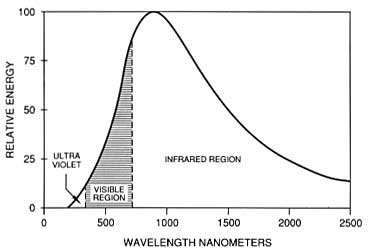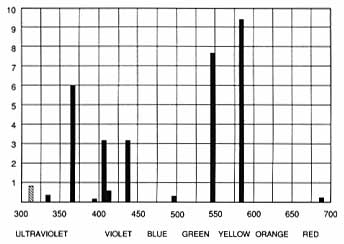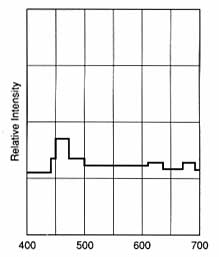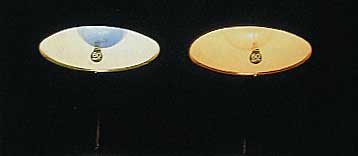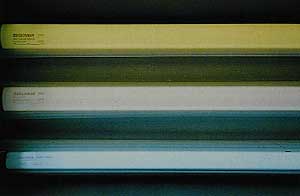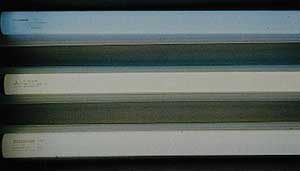Buying and Selling Gems:
What Light is Best?
Part II: Artificial Light – The Options Available
By William
J. Sersen, Ph.D., AG (AIGS)
Formerly of the Asian Institute of Gemological Sciences,
Bangkok, Thailand
Note: This article is reprinted with permission. It originally appeared in the Gemological Digest, Vol. 3, No. 1, 1990, pp. 45–56. To read Part I of this article, click here
Abstract:
What light source best qualifies as a standard for dealers
and graders of colored stones? Natural daylight isn’t
the answer, for it varies too much in strength and spectral
composition. That leaves only man-made lamps to choose from.
But which one? The author tries to answer that question,
reviewing the merits, disadvantages and operational theory
of a number of commercially available options. He concludes
by identifying a lamp that appears to meet all criteria
for a universal lighting standard.
Introduction
There was once a gem dealer named Rick O’Shea (his
friends called him Ricochet, for short). Living on a dreary,
foggy island off the coast of Ireland, a place where the
sun seemed to set more than rise, he grew accustomed to
grading his gemstones in dim lighting conditions. “What,
me use artificial lamps?” he would say jokingly to
his dealer friends who often gathered at their favorite
pub, The Loupe & Tweezers. “The stones wouldn’t
look natural if I did that, now would they?”
Ricochet thought that all gems were
dark-toned. Moreover, he had never seen asterism before,
despite what he read of it in his FGA course materials.
The light on his tiny island just wasn’t strong enough.
Sure, he believed that asterism existed, because the book
said so. Pluto was probably the ninth planet too. But light-toned
gems: “No way,” was Ricochet’s famous and
proverbial reply (a reply his wife learned to echo, nightly,
to poor old Ricochet: she liked having a lamp turned on,
but he refused to buy one).
Other dealers–those who lived
on the same island, but used artificial daylight lamps to
do their grading–loved doing business with Ricochet.
Secretly, they spoke of him as Ol’ Backfire, referring
to his business acumen. Australian customers called him
Boomerang for the same reason. His grading techniques were
legion: everyone knew that if Ricochet-Backfire Boomerang
wanted to sell cheaply a blue sapphire he considered too
dark in tone, that meant it was a more saleable medium tone
under everybody else’s lighting arrangements. After
repeated deals, Ricochet-Backfire-Boomerang went out of
business. Ultimately, he became a lonely and forsaken pessimist
whose dim view on gems extended to life generally.
To avoid falling into the trap that
snared poor Ricochet, let’s read on. Gem dealers who
read this article will easily relate it to MONEY. Professional
graders may regard it more as a contribution toward standardizing
gem-grading lighting conditions. Put simply, retailers will
either love it or hate it!
“What light source best qualifies as a standard for dealers and graders of colored stones? Natural daylight isn’t the answer, for it varies too much in strength and spectral composition. That leaves only man-made lamps to choose from. But which one?”
As we saw
in Part I of this article, dealers often buy and sell gems
under natural lighting conditions. Of those that do, most
prefer assessing stones with reflected skylight, not direct
sunlight. For latitudes north of the equator, north skylight
is frequently used as it contains the least glare; for latitudes
south of the equator, south skylight is the general rule
and for the same reason.
We also observed that the quality
of natural light varies dramatically with latitude, weather
conditions, atmospheric pollution, season and the sun’s
position in the sky. All contribute to the strength and
spectral composition of what we call natural daylight. Consequently,
a gem seen under daylight can and does change appearance
relative to where we are, what the weather is like, the
degree of pollution, the season and the time.
It is therefore incorrect to think
of daylight as a standard light source. For something to
be standard it should have constant properties, which global
daylight does not. If daylight were constant everywhere,
that dark stone bought in Bangkok would not look darker
in New York or Amsterdam. Nor would a blue sapphire necessarily
look better at 5 PM than at I PM – even at the same
latitude!
So what light source is best for
dealers and graders to view gemstones (Hold tight retailers,
we’ll get to you later)? In a sense, any light
source is best so long as it has constant properties and
is used consistently. Anyone who has spent time color grading
gemstones under specific lighting conditions, such as a
certain kind of fluorescent lamp, gets used to how stones
appear under that light. Abruptly switching to a
different kind of lamp, let’s say incandescent or even
a cooler or warmer fluorescent model, is tantamount to changing
the rules: the grader temporarily loses his bearings or
color “reference points.” The stones do not look
the same. The only cure for that ill is for our grader to
spend a lot of time looking at gems with the new lamp: long
enough time to re-establish his bearings. It is sort of
like target shooting with a favorite pistol; suddenly switching
to a different pistol results in an adjustment period before
one’s accuracy is back on par. In other words, it is
a question of what one is used to and thus feels comfortable
with.
But if a grader consistently uses
one light source by which to grade, and his colleagues each
use some other light source, then all will differ in their
grading results, even though each feels comfortable with
his respective lighting arrangement. This applies to gemstone
graders, cotton graders and even snakeskin graders (the
latter who would be hissing in the wind)!
Therefore, we must distinguish between
personal and universal lighting standards.
If somebody assesses the color quality of gems under one
type of light, and so is accustomed to how stones appear
relative to one another under that particular light, then
that person has established a personal lighting standard.
Only if everybody uses the same or similar lighting arrangement
does that standard become universal. The closest thing to
a universal lighting standard in the gem industry is the
GIA DiamondLite for diamond grading purposes. There is no
universal lighting standard for color grading colored stones.
“What light source best qualifies as a standard for dealers and graders of colored stones? Natural daylight isn’t the answer, for it varies too much in strength and spectral composition. That leaves only man-made lamps to choose from. But which one?”
Other industries,
such as the cotton and textile trades, have long ago made
headway toward defining universal lighting standards for
grading their commodities. Comparatively, the gem industry
is still in the dark ages. Why is this the case? Lack of
discussion on the subject, partly because of a lack of perceived
need to standardize, partly also due to the inherent conservatism
of the industry. This indifference has only harmed the trade
as a whole; with a multitude of personal lighting standards
but no universal standard, there can be no universal color
communication. After all, the color of any object depends
on three things: the object itself, the eye and the light
source. Assuming that graders and traders have “normal”
color vision, than we are left with only the object and
the light source. If you change either, you are apt to perceive
color differently. If the object is a colored gemstone,
that difference may translate into many dollars and cents.
So again, what light source should
dealers and graders use when viewing gemstones? For that
matter, does an ideal lamp exist? In order to answer those
questions, we must first examine in detail the criteria
for an ideal lamp and, equally important, how and
why we have chosen these criteria. Later we will
look at the lighting options commercially available: those
lamps that meet the grade, those that come close, and those
that fall short of the mark. In the course of this little
discourse, a few technical terms will arise, but –
worry not – nothing intimidating or unfathomable. We
promise that this brief submersion into the waters of illumination
theory and practice will be totally painless!
“…the quality of natural light varies dramatically with latitude, weather conditions, atmospheric pollution, season and the sun’s position in the sky. All contribute to the strength and spectral composition of what we call natural daylight.”
What Constitutes
the Ideal Lamp?
Criterion #1: Sufficient Strength
of Light
The majority of dealers polled in Part I of this
article said that light intensity contributed greatly to
the quality of a stone’s color appearance.
Indeed, what do dealers usually
do when another dealer or broker hands them a stone–at
least, dealers in Thailand, Burma, Sri Lanka and in parts
of Europe and the States? Answer: they hold it about a foot
away from a window and examine it under reflected daylight.
This reaction is so commonplace that it seems almost instinctive.
Usually, there are artificial lights in the same room, but
artificial lighting can not (in most cases) duplicate the
strength of natural daylight, especially on a clear or partly
cloudy day. And part of the reason why dealers bother to
take the stone to a window in the first place is because
natural light–at most latitudes and in most seasons–is
relatively strong.
It follows that a lamp used by dealers
for buying/ selling/grading should illuminate gemstones
as much as the light entering from a typical window. The
trick here is to define “typical window.” You
see, the amount of light that falls on a unit area, which
is what lighting engineers call the degree of illuminance,
depends entirely on window direction, latitude, season,
time and weather conditions.
Table I shows the average annual
daylight illuminance from 8 AM to 4 PM at 30°N to 50°N
latitude for windows facing north, east, south and west.
Clear, partly cloudy and overcast days are included in these
averages. Figures are in kilolux. A lux is a unit
of illuminance. To help put things into perspective, 1000
lux is roughly the amount of light a common photographic
light meter would register at about one foot from an 18-inch
(20 watt) fluorescent “daylight” lamp. Three thousand
lux is about what a 60-watt incandescent bulb produces at
one foot. Forty thousand lux and more is what that same
meter registers when placed right next to a Bangkok window
facing south on a clear day.
As you can see, there are huge differences
in illumination depending on the direction the window happens
to face. Predictably, daylight is dimmest with overcast
weather, equally so in all directions. Perhaps not so predictably,
north daylight is stronger when the weather is partly cloudy
than when it is clear. For latitudes south of the equator
(30° to 50°S) the same can be said for south daylight.
|
|||||||||||||||||||||||||||||||||||||||||||||||||||||||||||||||||||||||||||||||||
Within these same latitudes the average
illuminance for all window directions at all seasons, weather
conditions and times is slightly more than 19 kilolux. However,
north is the most glare free direction, which is why dealers
often use it when examining stones. Average illuminance
for a north-facing window at all seasons, weather conditions
and times, again for the same latitudes, is slightly over
six kilolux. In either case, this is far more illuminance
then that of 20-watt fluorescent daylight lamps at distances
of one foot or greater.
It seems reasonable, given dealer
habits and the above lux figures, that our ideal lamp should
similarly produce an illuminance in the range of six kilolux
at one foot distance.
Just how important is distance?
Distance is extremely important. A curious thing about light
is that in doubling the distance from a source, let’s
say a lamp or candle flame, the resulting illuminance is
not halved as one might think. For instance, if a lux meter
is held one foot from some lamp, a reading is taken, and
the process is repeated two feet away, the lux meter will
not register half the illuminance. It instead shows one
quarter the illuminance. Three feet away the illuminance
drops to 1/9th; at four feet to 1/16th; at five feet to
1/25th, etc. This is known as the inverse square law, and
is depicted in Figure 1. The law states that the amount
of light falling on a body or surface is inversely proportional
to the square of the distance.
This means that a lamp giving six
kilolux of illuminance at one foot would register 1.5 kilolux
at two feet, because the same quantity of light is spread
over four times the area. Six inches from the lamp, the
lux meter would read 24 kilolux (4 x 6).
The point is that if one selects
a grading lamp partly for its illuminance, the inverse square
law can not be ignored. When stones are graded, they
should be held at a specific distance from the lamp to help
insure consistent results. Deviating much from that
distance can affect the stone’s color appearance to
greater or lesser degrees.
Table 2 has further examples of
the inverse square law. If you feel more at home with footcandles
than lux, just multiply the lux figures times 0.10 for footcandles.
|
Criterion #2:
Ability To Make Objects Look Natural
Lighting helps dictate
how an object appears to our eyes. Lighting may be natural
or artificial. Few artificial light sources render color
the same way daylight does. As we have seen, not all phases
of daylight render color exactly the same way either.
So, what is meant by ability
to make objects look natural? For that matter, what
does natural mean? If something seems natural to us–it
could be a color, a smell or even an experience–all
that means is that we are accustomed to that “something.”
In this sense natural appearance and normal appearance
are synonymous. Both are subjective impressions; both are
relative to what we are used to; commonly, both mean much
the same thing.
For many colored-stone dealers,
gems look natural when observed in daylight. Since
this so often means a glare-free direction of daylight,
we can limit the discussion to north daylight. We have already
discussed average illuminance of north daylight. But, there
is something every bit as important as illuminance, and
that is spectral composition.
|
A light source
that provides the right amount of illuminance but is not
spectrally balanced is no good for grading, as it does not
render color adequately. It does not do so because it cannot
do so. Let’s pursue that point.
Many light sources that look white
to our eyes may vary drastically in spectral composition.
The more they vary, the more different they render object
color. For instance, daylight sources (natural and artificial)
and incandescent lighting look somewhat whitish to the eye.
Yet, why is an alexandrite red under incandescent light
and green under daylight?
Alexandrites transmit (= allow to
pass through) and reflect green and red wavelengths. Since
the spectrum of incandescent light is strong in red wavelengths,
Alexandrites have plenty of opportunity to transmit/reflect
red light when illuminated by that source, and so appear
red. They are green under man-made or natural daylight because
that kind of lighting contains more blue/green wavelengths.
Similarly, rubies seem a deeper
red under incandescent lighting than under most fluorescent
lamps. This is again because incandescent lamps give out
more red wavelengths than fluorescent lamps.
“Similarly, rubies seem a deeper red under incandescent lighting than under most fluorescent lamps. This is again because incandescent lamps give out more red wavelengths than fluorescent lamps.”
Blue sapphires
are another example. These stones look bluer under skylight
or cool white fluorescent lighting than under a warm white
fluorescent or incandescent lamp. In fact, deep blue or
medium-dark sapphires can look as black and inky as onyx
if displayed under a strongly illuminant incandescent lamp.
This is predictable, as skylight and cool white lighting
are very rich in blue wavelengths while incandescent lamps
are not.
Hence, the perceived color of gemstones
depends on the spectral composition of the source. Since
a gem transmits and reflects only certain wavelengths, the
source must contain those wavelengths or the incident light
is absorbed, making the stone appear black or gray. It is
for this reason that red paint is red under white light.
Red paint only reflects wavelengths that correspond to a
red visual sensation, absorbing all others. If that same
paint is viewed under a green light source, containing only
green wavelengths, it appears black. This is because the
paint absorbs the green wavelengths and has nothing to reflect.
An essential difference between paint and transparent gemstones
is that the latter transmit, reflect and absorb light whereas
paint can only reflect and absorb light.
Since we have chosen north daylight
as our model light source on the basis that it makes gems
look natural to many dealers, let’s examine
its spectral composition in detail.
|
The spectral composition of any natural or man-made light source may be measured and graphed. The graph is called a spectral power distribution (s.p.d.) curve. The curve states precisely how much light the source radiates at each wavelength. This helps tremendously in assessing the color rendering ability of the source.
Figure 2 shows the s.p.d.’s of four phases of natural daylight, the so-called CIE Standard Illuminants D50, D55, D65 and D75. The D50 is a white light with a fairly even curve in the visible spectrum. It is the evenness of this curve that gives this source a white appearance similar to noon sunlight. D55 contains a bit more blue and a bit less red. D65 and D75 are distinctly weighted toward the blue; their color appearance is comparable to a slightly overcast sky. Pure north skylight on a clear day is bluer still. The s.p.d. of north daylight (a mixture of skylight-and a little direct sunlight) is, like the D65–D75 curves, weighted toward the blue.
The apparent color of these illuminants is referred to as the color temperature. Color temperature is measured in degrees Kelvin. For instance, the color temperature of the D50 illuminant is 5000° K; that of D75 is 7500° K; incandescent lamps start at around 2600° K, which is a slightly yellow appearance.
For a quick appreciation of what color temperature is all about, see Figure 3. Table 3 clarifies the concept in greater detail and with more examples.
|
|
||||||||||||||||||||||||||||||||||||||||||||||||||||||||||||||||||||||||||||||||||||||||||||||||||||||||||||||||
If we know
only the color temperature of a lamp, then we know little
about the way that lamp renders object color. You see, the
approximate color temperature of a lamp can be inferred
from its s.p.d., but the reverse is not always true: the
s.p.d. can not always be inferred by the color temperature.
This is important, because s.p.d. determines the color appearance
of objects, such as gemstones; color temperature alone does
not.
Figures 4 and 5 are extreme examples
of how two lamps that look alike when lit, i.e., have similar
color temperatures, can render object color quite dissimilarly.
Figure 4 is the s.p.d. of a lamp having total output in
two bands of blue and yellow light. Figure 5 is a continuous
curve spectrum of a lamp with an output at all wavelengths
(= colors). In either case these lamps appear white
to the eye. But, what happens if we use them to illuminate
an object?
A red object appears black or gray
under the first source and red under the second. This is
because one lamp emits red wavelengths and the other does
not. A yellow sapphire would look yellow under either lamp,
since both emit yellow wavelengths.
So, the color temperature of a light
source is little indication of how it renders object color,
and two sources that look the same may render colors differently.
On the other hand, two sources with the same or similar
s.p.d. must render color the same way.
|
Browsing through lighting-manufacturers’ catalogs, one comes across the terms Ra or C.R.I., which stand for Color Rendering Index. This index is supposed to tell us how well a lamp renders color compared with a reference source of the same color temperature.
Color Rendering Index was the brainchild of the Commission Internationale de l’Eclairage, better known as the C.I.E. The idea is simple in principle. A minimum of eight sample colors, consisting of (opaque) Munsell papers, are viewed under each source. If in both cases the color of all the papers looks the same–in other words, there is no color shift compared to the reference source– then the test lamp has a C.R.I. of 100, the highest rating. Reference sources are automatically rated at C.R.I. 100.
|
As a rule
of thumb, this means that a lamp rated at C.R.I. 90 renders
color 90% as well as some reference source; C.R.I. 80 indicates
an 80% rendition, etc.
In this writer’s opinion there
are three problems with published C.R.I. data. The first
is that C.R.I.’s are mean indices, averages
of how a lamp renders/distorts the color of all the test
papers. This is fine and dandy, but the corollary is that
a lamp can receive a fairly high mean rating even
though it may do a miserable job of rendering the color
of one of the Munsell test papers. Which one? Lighting
catalogs are silent on that point. Try writing the manufacturers
for that information, you say? Good luck!
The second problem with published
C.R.I.’s is that the reference source/illuminant against
which the lamp is rated is usually not specified. In theory,
lamps having a color temperature of less than 5000°
K should be rated against a Planckian radiator of the same
color temperature. For temperatures above 5000° K,
the s.p.d.’s of C.I.E. Standard Illuminants should
serve as the reference. Whether manufacturers actually use
these references is an open question, as lighting catalogs
are again generally silent on that point.
And finally the third problem: even
if a lamp gets a rating of C.R.I. 100 with respect to a
defined reference source, this rating is only applicable
for the Munsell papers used in that particular test.
It is no guarantee that other papers of other colors would
be color-rendered as faithfully.
C.R.I. ratings are a powerful sales
tool in marketing lamps purchased by the print industry
and others for color critical applications. But, in view
of the above, readers are cautioned to interpret these ratings
with a grain of salt.
The Options Available
We have outlined what we expect of the ideal lamp.
We have done this in context of basic illumination theory,
whenever possible emphasizing color-rendition aspects. Now
it’s time to look at specific types of artificial light
sources: the commercial options that are actually available
to us.Fluorescent Lamps
First introduced in 1938, fluorescent lamps use a low-pressure
mercury-vapor arc to produce ultraviolet (U.V.) radiation
at 253.7 nm. The glass tubes of these lamps are coated with
phosphors that absorb the U.V. and convert it to visible
wavelengths. The chemical composition of the phosphors determines
the wavelengths of the generated light and, hence, the lamp’s
color temperature.
Fluorescent lighting is often used
in office buildings, due to cost effectiveness. This is
because these lamps can produce more lumens per watt
(= amount of light per unit of consumed power) than incandescent
lamps. For instance, a 16-watt fluorescent tube yields as
many lumens per watt as a 60-watt incandescent bulb.
Figures 6 and 7 are the s.p.d. curves
for warm white and cool white fluorescent sources.
The warm white lamp is rich in red energy, while the cool
white lamp has more blue energy. Typically, these curves
show both continuous and narrow-band energy emissions. The
continuous spectrum is emitted by fluorescent phosphors.
The narrow-energy bands are due to the mercury arc, and
occur at 404.7 (violet), 435.8 (blue), 546.1 (green) and
578 (yellow).
|
|
Figure 8 is the s.p.d. of a fluorescent “daylight lamp.” You will note that though it is less weighted toward the red or blue than the warm and cool-white lamps, it still contains the same mercury-arc peaks. These peaks or narrow-energy bands do not occur in natural daylight, which is a continuous curve spectrum of greater relative intensity.
|
Prototypes of this lamp were devised independently in 1878 by Swan in Great Britain and Edison in America. The modern version consists of a high resistance tungsten-wire filament within a glass bulb containing a vacuum or gas. Lamps over 40 watts are usually filled with a mixture of inert gases, such as argon and nitrogen. Pressure from the gas restrains filament evaporation and allows higher filament temperatures. Lamps of less than 40 watts are normally of the vacuum type.
When voltage is applied to an incandescent lamp, the current passing through the filament meets resistance. Power is consumed which makes the filament glow. Put another way, the consumed power heats the filament to incandescence.
Incandescent lamps are commonly used in many households even though they are not as cost effective as fluorescent lighting and do not render color as adequately as, say, daylight fluorescent lamps. Perhaps the reason for this is that some people are so used to having incandescent lamps in their homes that–in the household at least–any other kind of lamp seems unnatural. If so, this is just another example of the subjectivity that underscores the natural vs. unnatural concepts discussed earlier.
|
Figure 9 is a typical s.p.d. curve for an incandescent lamp. As you can see, energy emission is mostly in the infrared, with only a small amount in the visible region. As with natural daylight, this curve is strictly a continuous spectrum, without the narrow band emissions of fluorescent lighting. Unlike natural daylight (other than direct sunlight at sunrise and sunset), most of the visible emissions consist of red wavelengths.
Discharge Lamps
Electric-discharge lamps radiate light produced by the
passage of current through a gas or vapor. The latter may
consist of sodium, neon, argon, mercury, helium, xenon or
various gas combinations.
Discharge lamps can be expensive.
Many have a relatively short life span. Some require out-of-the-ordinary
startup circuitry, careful voltage regulation and cooling
apparatus. A few models generate enough U.V. to make the
Ozone Layer shiver. Sound pretty negative? Give them a chance
and read on, for you may be in for a surprise.
|
Low versus high pressure.
Discharge lamps are made for special applications, including
street lighting, searchlights, signal beacons and film projectors.
There are as many kinds of discharge lamps as there are
applications. Most can be divided into two broad categories:
low- and high-pressure discharge lamps.
All low-pressure and most high-pressure
varieties lack a continuous spectrum. For some, the total
energy emission consists of narrow bands at certain wavelengths.
In other words, the output is limited to one or more regions
of the light spectrum. Consequently, the color rendition
of this type of lamp is, to put it bluntly, lousy.
The s.p.d. of one kind of low-pressure
discharge lamp is shown in Figure 10. Notice that the output
largely consists of one line in the yellow, one in the yellow-green
and two in the violet. There is an almost total absence
of red radiation. As a result the emitted light is bluish-violet,
which is the additive mixture of these colors.
This type of discharge lamp was
a boon to the London police of the 1 930s. Prostitution
was then common in London, even more so than now, and all
the friendly hookers wore (no pun intended) plenty of red
lipstick and rouge. The red lights of the Red Light District
made red makeup look redder than ever! When London’s
city administration decided to use discharge lamps for street
lighting, the situation climaxed for street walkers, in
that these lamps made their red makeup appear brownish gray.
A sudden drop in business resulted (Kaufman, 1984).
|
High-pressure
discharge lamps include mercury, sodium and short-arc varieties.
The mercury and sodium types render color poorly. However,
high-pressure short-arc lamps, particularly certain xenon-filled
models, offer excellent color rendition.
Short-arc lamps are called such
because the distance between the electrodes is small (1–10
millimeters). Some xenon models generate an arc color that
closely approximates natural daylight at 6000° K. Their
spectrum is continuous from the ultra-violet into the infrared.
As evident from Figure 11, the continuous spectrum in
the visible range is very reminiscent of natural daylight
at 6000° Kelvin. One West-German manufacturer,
OSRAM, G.M.B.H., recommends a 150-watt version of their
xenon short-arc lamp for critical color matching purposes,
including spectrophotometric applications. The illuminance
of that lamp is strong, much more than a 150-watt incandescent
bulb or any fluorescent lamp; in other words, lots of lux!
Figure 12 depicts a short-arc xenon
lamp of this type. The rendition is actual size.
So What Light Is Best?
An Ideal Lamp for
Dealers and Graders?
Is the xenon short-arc lamp the answer to the dreams
of colored-stone dealers and graders? Its spectrum is balanced
and similar to that of a slightly-bluish phase of natural
daylight. The mercury peaks characteristic of all fluorescent
lamps–including so-called daylight fluorescent lamps–do
not exist in the spectrum of xenon short-arc lamps. Additionally,
these lamps produce an exceptionally strong illuminance
reminiscent of natural daylight.
|
How About a Lamp for Retailers?
Up till now, the discussion has been limited to light sources for colored stone dealers and graders. What about retailers?
It is common when retailing colored gemstones to display them in the most complimentary light possible. For example, incandescent (including highly illuminant tungsten-halogen) lamps are often used with ruby displays. As we saw earlier, this type of lighting accentuates red stones. When these lamps are tinted red and/or used in conjunction with purplish-red reflectors, complimentary is no longer the best word to describe the effect: enhancement is more appropriate. Most retail customers do not realize that the beautiful deep-red ruby they admire under such exaggerated lighting conditions may look comparatively washed-out once they step outside the store.
If retailers wish to display stones in a complimentary light, then they might consider one of the following lighting arrangements:
- Incandescent or warm-white fluorescent lamps for red/orange/yellow stones (Figures 13 and 14).
- Cool-white or daylight fluorescent lamps for green/blue/violet stones (Figures 14 and 15).
|
The Mitsubishi Daylight 99 fluorescent lamp is used for grading gems in two AIGS classes: the colored stone grading class and the appraisal class. Having taught both classes for the past two years, the author has some definite opinions on the Daylight 99. Its color rendition of colored stones is fairly balanced, though it lacks the degree of illuminance obtained from natural daylight. Moreover, it is not quite long enough to fit into standard sockets–at least, sockets readily obtainable in Thailand (which accommodate every other fluorescent bulb the author has come across). It does, however, fit perfectly in Mitsubishi-made sockets, which sell for CONSIDERABLY more than the standard-length socket arrangement.
The Sylvania Design 50 daylight lamp renders the color of gems very much the same as the Daylight 99. In Thailand, the Daylight 99 retails for over US $100 (including the socket-arrangement); the Design 50 currently sells for about $5 and its standard-length socket/holder is available in most local stores for $2–3. Like the Daylight 99, the Design 50 lacks the strong illuminance of natural daylight
The Osram (XBO-series) short-arc xenon lamp may be the answer to everyone’s prayers, wholesaler, grader and retailer alike. One disadvantage, however, is the price: they are much more expensive than most conventional fluorescent or incandescent (including tungsten-halogen) lamps.
|
In Summary
Artificial light sources, not unlike the diverse phases
of natural light, vary considerably in their properties.
As a result, some lamps render an object’s color better
than others do.
The most important criterion for
assessing the color-rendering ability of any lamp is its
spectral power distribution curve. Color temperature and
C.R.I. information alone tell us relatively little.
Natural daylight varies too much
in strength and spectral composition to be taken seriously
as a lighting standard for grading and dealing colored stones.
For anything to be a standard, it must be constant in its
properties, which natural light is not. Yet, many dealers
prefer using natural light, often skylight, when buying
and selling stones.
For dealers in particular to make
the transition from natural light to an artificial light
source, that source must offer:
- A degree of illuminance at least as strong as the common phases of natural daylight.
- Spectral properties identical or comparable to a phase of natural daylight.
A source combining these two things
makes gems appear much the same as when viewed under a given
phase of natural light. From the viewpoint of many dealers,
this corresponds to a natural appearance.
Of the many kinds of lamps examined
in this article – incandescent, fluorescent and discharge
– the 6000° Kelvin xenon short-arc lamp appears
closest to meeting the criteria for a standard light source.
Besides the strong illuminance this lamp affords, its spectrum
is very similar to CIE standard illuminants of similar color
temperature. Here it is important to remember that CIE illuminants
are in turn derived from actual measurements of natural
daylight.
If cost is a major concern, one
can hardly go wrong with daylight fluorescent lamps. Though
they lack the strong illuminance of natural daylight, and
are not faithful to the comparatively smooth-curve spectrums
of natural daylight or xenon lamps, they nonetheless render
gemstone color fairly adequately. Hence, these lamps may
serve as a low-cost substitute.
The lighting needs of most retailers
differ from those of dealers and graders. Graders want to
examine gems in as objective a light as possible –
a light that neither enhances nor detracts from the stone’s
color. In contrast, the majority of dealers want to at least
buy their stones under like conditions, while retailers
tend to favor lighting that is more complimentary to the
gems they display. This basic difference in philosophy (and
business approach) makes it difficult for one standard light
source to ever be adopted by graders, dealers and
retailers.
Dealers – perhaps more than
anyone else – will appreciate the advantages of buying
gems under consistent lighting conditions. Standard lighting
minimizes guesswork and hence the dollar risk. At
the least, it helps set the guesswork and dollar risk at
more predictable levels.
For dealers wishing to conduct evening-business,
the xenon short-arc lamp may be the lighting answer for
buying and selling. A virtual clone of natural daylight,
it is certainly worth exploring for this purpose.
![]()
Acknowledgements
The author wishes to thank the following individuals,
companies, organizations and schools for their kind assistance
and patience, without which this article could not have
been written: Mr. Pakorn Borimasporn, General Manager, GTE
International, Thailand; GTE Products Corporation, Danvers,
Massachusetts, USA; Professor Dr. Pramoht Unhavaithaya,
Faculty of Engineering, Chulalongkorn University, Bangkok,
Thailand; Mr. Richard W. Hughes, Director, Asian Institute
of Gemological Sciences, Bangkok, Thailand; Mr. Ted Themelis,
President, GemLab Co., Florida, USA; The International Commission
on Illumination (CIE), Paris, France; The Japan External
Trade Organization (JETRO), Bangkok, Thailand.
Additional thanks are due the following: Mr.
Apichart Assavapokee of Philips Electrical Co. Of Thailand,
Ltd.; Messrs. Niyom Raksasutiphan and Sakonchai Adunyanon
of Applied Color Systems, Bangkok, Thailand; Mr. Yongyooth
Rattana O Pas of Buntanaphan Electric Co., Ltd., Bangkok,
Thailand; Mr. Jan Goodman of Centerstone, Ltd., Bangkok,
Thailand; M.R. Diaz, Director International Operations,
Duro-Test International Corporation, New Jersey, USA; Toshiba
Corporation, Lighting Division, Tokyo, Japan.
Notations
Tables I & 2 and Figure 2 were generated by the
author. The average lux figures in Table 1 were extrapolated
from the IFS Lighting Handbook - Reference Volume
(Kaufman, 1984). The composite spectral power distribution
curves in Figure 2 were derived from data on CIE Standard
Illuminants published by ASTM (1987).The information in
Figure 4 was derived from the following sources: ASTM (1987),
Allphin (1973), GTE Products Corporation (LA-570R, PL-150
and 0-341) and Driscoll (1978).
References
- Allphin, Willard (1973) Primer of Lamps and Lighting, 3rd ed., pp. 38–40.
- ASTM (1987) ASTM Standards on Color and Appearance Measurement. Philadelphia, PA, pp. 151–160.
- Cricks, Howard (1951) Illumination. The Focal Press, London and New York, pp. 88–146.
- Driscoll, Walter G. (editor) (1978) Handbook of Optics. McGraw-Hill, Inc., New York, pp. 3/65–3/66.
- General Electric Co. (n.d.) Engineering Bulletin TP-119.
- GTE Products Corporation, Sylvania Lighting Center, Danvers, Massachusetts:
- (n.d.) Color is How You Light It, LA-570R.
- (n.d.) Fluorescent Lamps, Engineering Bulletin 0-341.
- (n.d.) Incandescent Lamps, Engineering Bulletin 0-324.
- (1988) Large Lamp Catalog, PL-150.
- (1988) Understanding Lighting, LA-656.
- (1984) Lighting Handbook, 7th ed., pp. 61–64.
- GTE-Sylvania S.A. (n.d.) Quick Spec. Geneva, pp. 1/22–1/29.
- International Commission On Illumination (1970) Daylight: International Recommendations for the Calculation of Natural Daylight. CIE No.16/ E-3.2, Paris, pp. 4–20.
- International Commission on Illumination (1974) Method Of Measuring and Specifying Color Rendering of Light Sources. CIE No.13.2, Paris, pp. 9–14.
- Kaufman, John E. (editor) (1984) IES Lighting Handbook – Reference Volume. Illuminating Engineering Society of North America, New York, pp. 5/1–5/31, 7/1–7/31, 8/39–8/57.
- Kueppers, Harald (1982) The Basic Law of Color Theory. Barron’s Educational Series, Inc., New York, pp. 101–161.
- OSRAM, G.M.B.H. (n.d.) XBO Short Arc Xenon Lamps, pp. 12, 16–21.
- White, Harvey E. (1959) Physics: An Exact Science. D. Van Nostrand Co., Inc., New York.
